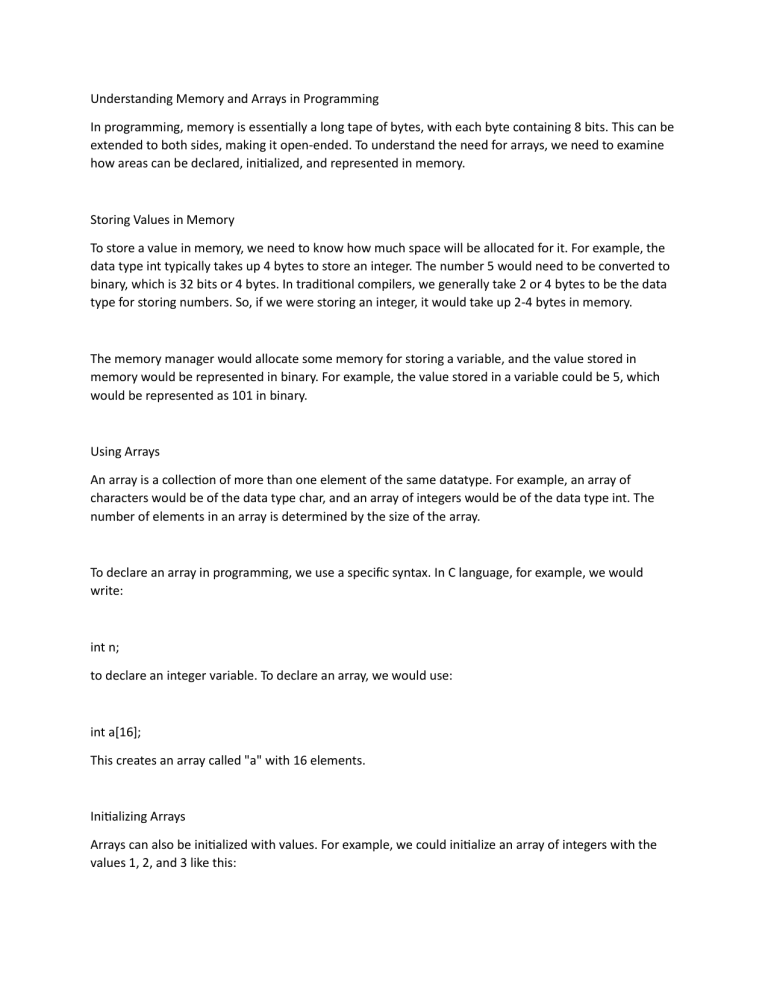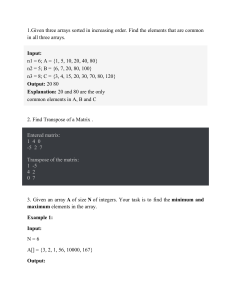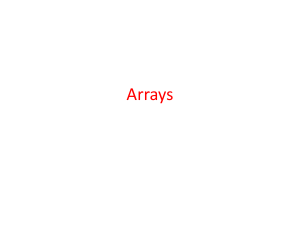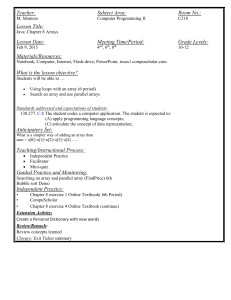
Understanding Memory and Arrays in Programming
In programming, memory is essentially a long tape of bytes, with each byte containing 8 bits. This can be
extended to both sides, making it open-ended. To understand the need for arrays, we need to examine
how areas can be declared, initialized, and represented in memory.
Storing Values in Memory
To store a value in memory, we need to know how much space will be allocated for it. For example, the
data type int typically takes up 4 bytes to store an integer. The number 5 would need to be converted to
binary, which is 32 bits or 4 bytes. In traditional compilers, we generally take 2 or 4 bytes to be the data
type for storing numbers. So, if we were storing an integer, it would take up 2-4 bytes in memory.
The memory manager would allocate some memory for storing a variable, and the value stored in
memory would be represented in binary. For example, the value stored in a variable could be 5, which
would be represented as 101 in binary.
Using Arrays
An array is a collection of more than one element of the same datatype. For example, an array of
characters would be of the data type char, and an array of integers would be of the data type int. The
number of elements in an array is determined by the size of the array.
To declare an array in programming, we use a specific syntax. In C language, for example, we would
write:
int n;
to declare an integer variable. To declare an array, we would use:
int a[16];
This creates an array called "a" with 16 elements.
Initializing Arrays
Arrays can also be initialized with values. For example, we could initialize an array of integers with the
values 1, 2, and 3 like this:
int a[3] = {1, 2, 3};
Representing Arrays in Memory
To represent an array in memory, we need to know how the elements of the array are stored. In a onedimensional array, the elements are stored in a single row with multiple columns.
Each element of the array takes up space in memory, depending on its data type. For example, an array
of integers would take up 2-4 bytes of memory per element.
Overall, understanding memory and arrays is crucial to programming, as they are fundamental building
blocks of many programs and applications.
Arrays in Memory
In this video, we will discuss how data is stored in arrays in memory. All the elements in an array are
stored in consecutive/continuous locations with the index starting at zero. The array can be statically
initialized at compile time or dynamically initialized at runtime.
One important point to note is that arrays are fixed-size. The elements are stored in
sequential/continuous locations with each element taking up the same amount of memory.
Accessing Array Elements
The index of the array starts at zero (although it can start at one in some cases). The size of the array is
the number of elements it can hold (n), with the index ranging from 0 to n-1. To access an element, use
the formula: base address + (i * size of data type).
The array follows the random access method, and accessing an element has a time complexity of O(1).
Dynamic Allocation
The drawback of arrays is that the size needs to be specified at compile time, which may not always be
possible. We may not know how much space we need until runtime. If we allocate more space than
needed, there will be unused memory. If we allocate less space than needed, we will run out of memory.
To dynamically allocate memory, we use functions such as 'malloc' and 'calloc'. The amount of memory
allocated is not contiguous, and the location of the data may not be known.
Error Handling
Unfortunately, there were some errors in the original text, making it difficult to understand. I have
paraphrased and corrected the text to make it more readable. If you encounter any errors, please let me
know.
Working with Arrays in Java
At runtime, loops and standard functions like Scanner can be used to take user input and store it in
arrays. In the next video, we will discuss how to initialize an array at compile time and how to store data
in the array at runtime. We will also cover how to use arrays and how to access data from them.
Additionally, we will examine memory management and show how to use it to test our own code.
In this video, we've discussed the declaration, initialization, and accessing of 1D arrays. In the next video,
we will cover how to insert data into arrays, traverse arrays, and work with 2D arrays. We will also
discuss how data items are stored in continuous locations and how random access works.
Arrays can have drawbacks, such as requiring elements of the same data type and not knowing the index
value. However, we have provided formulas and examples to help with these issues.





